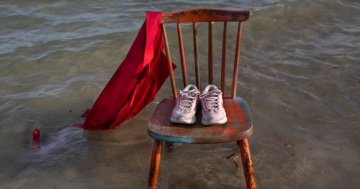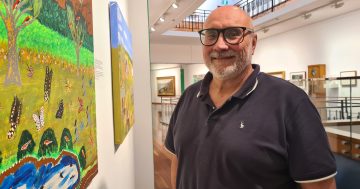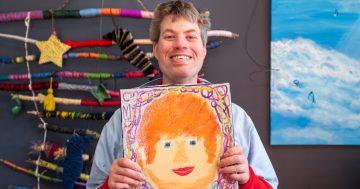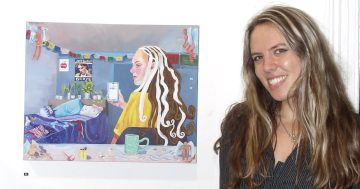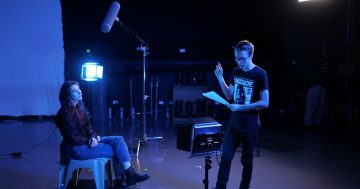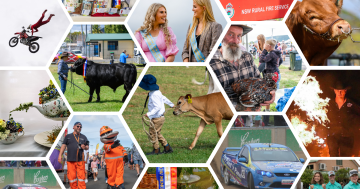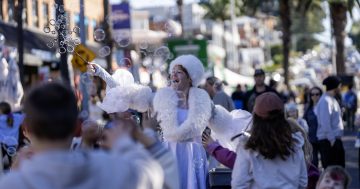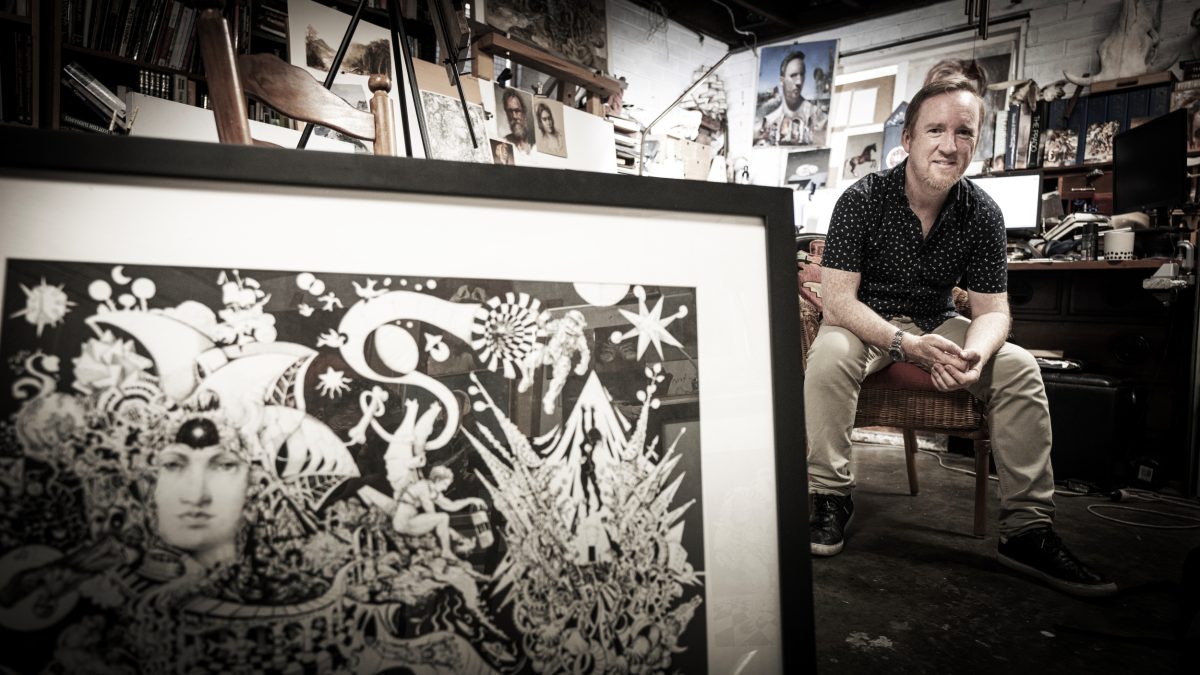
Artist John Kennedy in his studio. Photos: UOW.
UPDATED, Wednesday 10 January: The Peregrine suffered a fuel leak just hours after take-off and will be unable to complete its journey to the moon. Its operator, Astrobotic, said its new goal is to get the craft “as close to lunar distance as we can before it loses the ability to maintain its sun-pointing position and subsequently loses power”.
John Kennedy, a West Wollongong-based artist working under the name Jedika, is known for his surrealist art, or as he prefers to call it, “imaginative realism”.
His intricate, captivating artworks – a blend of drawing, painting, and sketching – explore the richness of humanity and curiosity.
For John, art, poetry and science all co-exist in his work on a foundation of creativity and innovation.
A few years ago, in the midst of the COVID-19 pandemic, John received a message through social media that would change his life. His artwork was going to the Moon.
Although John initially thought it was a prank or a scam, his artwork had captured the attention of Dr Samuel Peralta, a physicist, storyteller and filmmaker who is the pioneering force behind the Lunar Codex, a creative initiative that was on board the Peregrine Lunar Lander when it took off from Cape Canaveral on Monday (8 January).
John was chosen from among 30,000 creative artists around the world to be involved in Lunar Codex.
A series of five time capsules containing a wealth of creativity from 162 countries and territories and 67 Indigenous peoples, the Lunar Codex is the first project of its kind – a global arts collection that will be launched into space.
Dr Peralta described it as “a project to spread hope during a dark time”.
“The Lunar Codex attempted to instil the Moon with some of the heart of humanity, our art, so that when we looked to the sky, the Moon might become a tangible symbol of hope, of what is possible when you believe.
“The Codex is also a message-in-a-bottle to the future so that travellers who find these time capsules might discover some of the richness of our world today. It speaks to the idea that, despite wars and pandemics and environmental upheaval, humankind found time to dream, time to create art.”
A select few of John’s pieces will be part of two of the voyages that will travel to the Moon in the coming year.
John’s art will be included in the treasure trove of creativity that left Earth this week and will return on 23 February as part of the Peregrine Collection. The time capsule will land on the Moon in an area called Sinus Viscotatis on 25 January.
Later in the year, John’s poem ‘Fire’ will be included in the Polaris Collection, leaving Earth in November 2024 for Nobile Crater in the Lunar South Polar.
An Australian arts TV program that John has appeared on, Colour In Your Life, will also be part of the same mission.
John’s drawings and the other artists’ works have been digitised on two microSD cards. The cards are then placed into DHL MoonBox capsules attached to the first commercial Lunar Payload named the Astrobotic Peregrine Lunar Lander.
It is an incredible, mind-expanding opportunity for John, who graduated from UOW with a Bachelor of Creative Arts and a Master of Teaching (Secondary).
“It never once entered my mind that such a notion was even possible. It still feels surreal,” John said.
“Even after some time for the news to sink in, it doesn’t seem quite real.
“It’s an amazing feeling to be included in this incredible project. It’s difficult to describe in words. My kids have been getting excited about this as it gets closer. A part of our family will be up on the Moon. It doesn’t get much better than that. Our kids, in years to come, can look up at the Moon and know that a part of them is up there.”
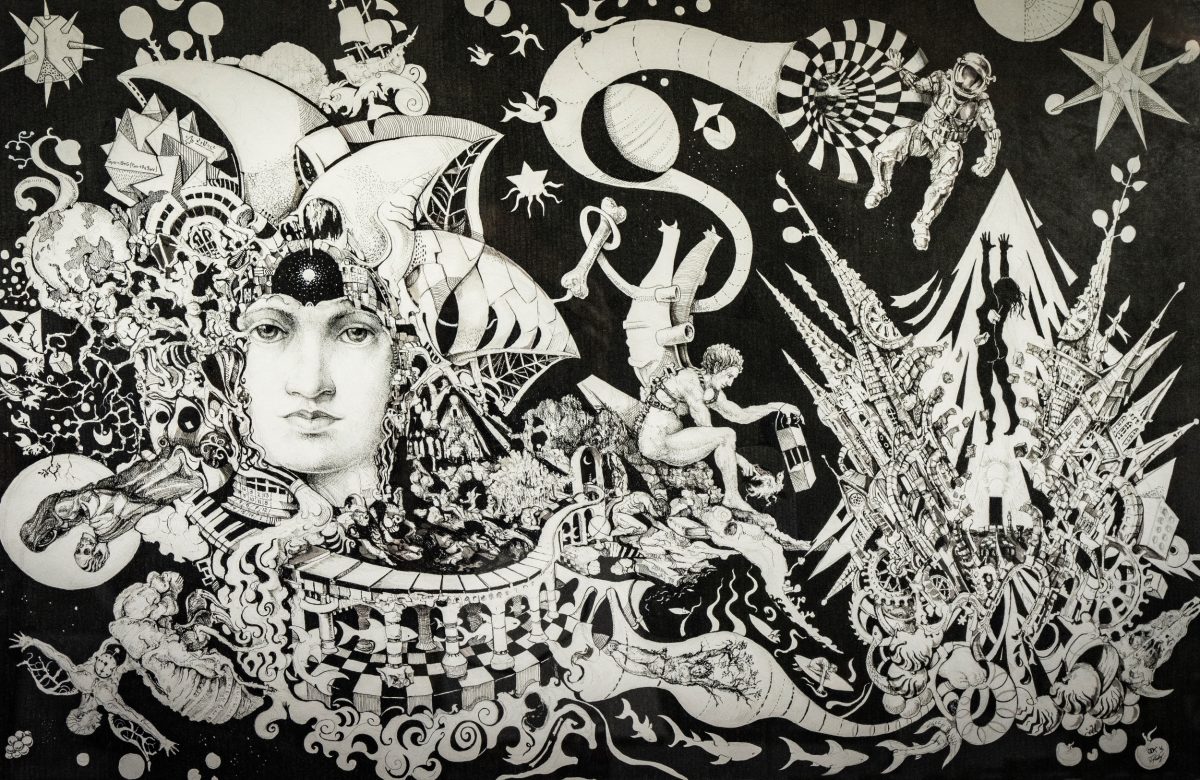
One of John Kennedy’s artworks being sent to the Moon.
Artists do not pay to be involved in the project; their work, be it film, poetry, art, or music, is selected if it aligns with the overall vision of the project.
While the rockets that contain the collection will return to Earth, the time capsules will remain on the Moon permanently.
The project fits into the United States’ ambition to put people on the Moon again.
Known as Artemis, the NASA missions will land the first woman and the first person of colour on the Moon and use innovative technologies to explore more of the lunar surface than ever before. NASA is collaborating with commercial and international partners and establish the first long-term presence on the Moon.
In many ways, it seems John was destined to be involved in the Lunar Codex. He shares a name with the former President of the United States, after whom the Kennedy Space Center at Cape Canaveral is named.
“It makes me feel very providential and presidential all at once,” he said.
“But there is another coincidence. One of my drawings included on the mission touches on the novel 2001: A Space Odyssey. By chance, the DNA of Arthur C Clarke, who wrote [The Sentinel, the book on which the film was based], will be included on the same launch.”
John has considered himself an artist since he was 13, when he began to draw and paint and dreamt of a career in art.
However, he remembers creating his first artwork when he was five. It is in his bones and he loves to share his creativity and expertise with others.
His work has been exhibited throughout the world, in Australia, Turkey, England, France and Italy, and for many years he has taught art through Levers in Wollongong.
However, in the past few years, John has formalised his teaching qualifications with a Master of Teaching (Secondary) from UOW.
Being part of the Lunar Codex gives his students a chance to dream of the possibilities of sharing their art with the world.
John said the project also demonstrates the equality of art. You do not need to be a famous artist to be included in the Lunar Codex or share your artistic gifts with the world.
“The Lunar Codex curation is an act of levelling the playing field. This is not exactly a notion that you think up or dream about. It is, quite simply, one of the most unexpected and phenomenal gifts so freely dropped at my doorstep.”
This article was written by India Lloyd and first appeared in the University of Wollongong’s The Stand publication.








